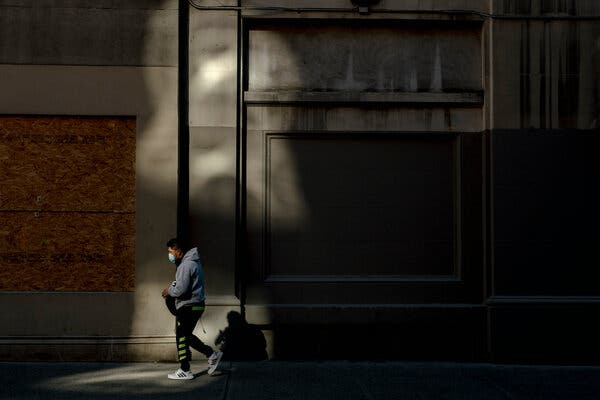Weather: Foggy early, then mixed sun and clouds. High in the low 70s.
Alternate-side parking: In effect today. Suspended tomorrow for Veterans Day.
By and large, New Yorkers are wearing face masks and practicing social distancing. Many public school students are learning remotely, and just a fraction of office workers in the city have returned to their cubicles. Restaurants are permitted to use only a quarter of their indoor tables.
Still, as winter nears, the number of coronavirus cases in New York City is ticking upward, mirroring a worrisome trend across the Northeast and the country.
On Monday, Mayor Bill de Blasio said a second wave was “getting dangerously close.” Rising infection rates, he warned, could lead to more stringent restrictions.
[Read more about how the surge could threaten the city’s recovery.]
Here’s what you need to know:
The numbers
City officials are alarmed that the number of new infections has climbed above 1,000 for five days in a row. In contrast, that figure was mostly in the 500 to 700 range in early October; at the height of the pandemic, the city reported over 5,000 cases on a single day.
[See our map of New York City coronavirus cases by ZIP code.]
Citywide, the seven-day average test positivity rate was 2.26 percent on Monday. (The seven-day average takes into account the trends from the previous six days.)
The data has shown that cases are up in all five boroughs, with Tottenville on Staten Island, Richmond Hill in Queens and the Concourse and Highbridge areas in the Bronx having among the highest test positivity rates over the past seven days.
The context
The city’s contact-tracing program has disclosed little about which trends and patterns are contributing to transmission. One city health official told my colleague Joseph Goldstein that clusters had been traced to workplaces, specifically construction sites and offices.
The number of new cases was also increasing in New Jersey, where Gov. Philip D. Murphy called for restaurants and nightclubs to end indoor service at 10 p.m. starting Thursday. He also barred high school sports teams from participating in out-of-state tournaments.
In Connecticut, Gov. Ned Lamont has limited indoor and outdoor private gatherings to 10 people, among other restrictions, in an effort to beat back the virus.
And on Monday, as President-elect Joseph R. Biden Jr. laid out his strategy to fight the pandemic, the United States again reported more than 100,000 new daily cases.
The advice
Mayor de Blasio seems reluctant to impose new restrictions — which would have to be formally implemented by Gov. Andrew M. Cuomo — but he and city health officials have discussed the possibility of a broader shutdown of nonessential businesses should the seven-day positivity rate reach, and stay, above 3 percent.
The mayor has previously said that indoor dining should be halted if the citywide rate reaches 2 percent, which it has. But he has not yet acted to curb the practice.
Councilman Mark Levine of Manhattan, who is chairman of the City Council’s Health Committee, told Mr. Goldstein that “the window is closing to prevent much more aggressive shutdown measures.”
As New Yorkers brace for cold weather, the strategies to keep the virus at bay remain the same: Wear a face covering, keep social distance and wash your hands. If you feel sick, stay home, except to get medical care.
From The Times
She Was Found Dead and Dismembered. Prosecutors Say They Now Know Why.
N.Y.P.D. Will No Longer Force Women to Remove Hijabs for Mug Shots
Moving to New York to Start Their Dance Careers
Want more news? Check out our full coverage.
The Mini Crossword: Here is today’s puzzle.
What we’re reading
Starting Dec. 1, the Verrazzano-Narrows Bridge’s one-way toll will be split in half and charged in both directions. [Staten Island Advance]
A New York City police officer was charged with assisting a drug-trafficking organization. [Daily News]
An animal shelter on Staten Island was forced to evacuate all of its animals because of unsafe conditions. [New York Post]
And finally: Chased by a firefighter
From The Times’s Modern Love podcast:
They disagreed on a lot of things: She was a “bleeding-heart liberal”; he was a “conservative libertarian.” He “came from good Irish Catholic stock”; she called herself a “hopeful agnostic.”
When the firefighter (named Stephen J. Brady) chased Marlena Brown down the street to ask her out, she pinned him as “a bald, white, middle-aged New York City cliché.”
On their first date, no topic was off limits. Not racism, not abortion, not substance abuse. With each date, another debate.
Ms. Brown’s story about the space she and Mr. Brady found in each other — and the unexpected aftermath of their breakup — was featured recently in The Times’s relaunched Modern Love podcast, hosted by Daniel Jones and Miya Lee. While Modern Love’s essays don’t always take place in New York, their themes may well resonate with the millions of people who call the city home.
In February, within hours after Ms. Brown’s piece about the firefighter was published in Modern Love, The Times received a flood of emails from people who knew him well.
“When it came to our core values,” Ms. Brown told Mr. Jones, “we were actually coming from the same place.”
It’s Tuesday — follow your heart.
Metropolitan Diary: Italian ices
Dear Diary:
When I was young, we would visit relatives in Astoria every summer.
My aunt lived in apartment building on 29th Street. Every day, she would give me a dime so that I could buy a tiny cup of Italian ice. The man who sold it stood outside the bakery owned by Christopher Walken’s parents.
I had never tasted anything so luscious. Sometimes, I would steal another dime from my aunt’s pocketbook to buy another.
— Susie Polden
New York Today is published weekdays around 6 a.m. Sign up here to get it by email. You can also find it at nytoday.com.
We’re experimenting with the format of New York Today. What would you like to see more (or less) of? Post a comment or email us: [email protected].



















